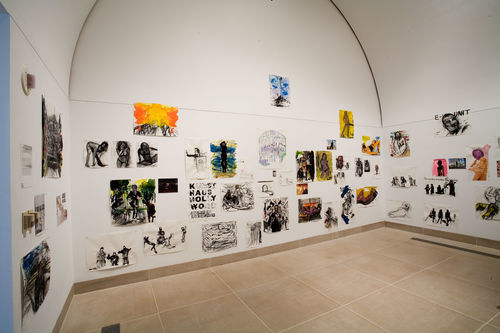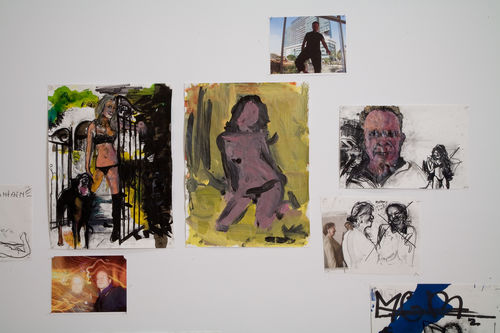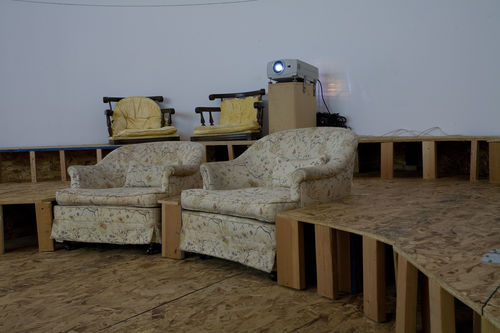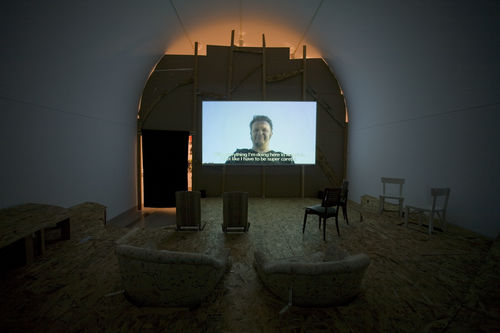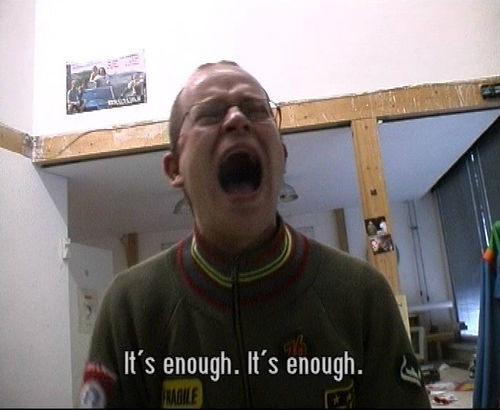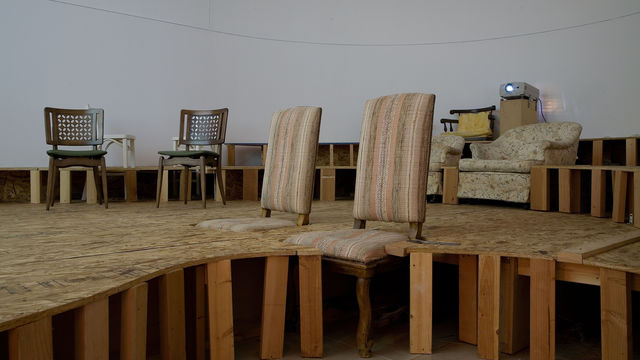
Hammer Projects: Erik van Lieshout
- – This is a past exhibition
With his camera always on, Dutch artist Erik van Lieshout sets out on spirited journeys, turning whomever or whatever he encounters into subject matter for his social documentaries. His endless curiosity and his disarming personality encourage strangers to share their intimate feelings and politics openly with him. In his drawings, paintings, and collages, van Lieshout continues this ferocious exploration of the behaviors of people he meets with aggressive, sometimes violent, sexual imagery. The artist produced a new video for the Hammer Museum while living in and learning about Los Angeles.
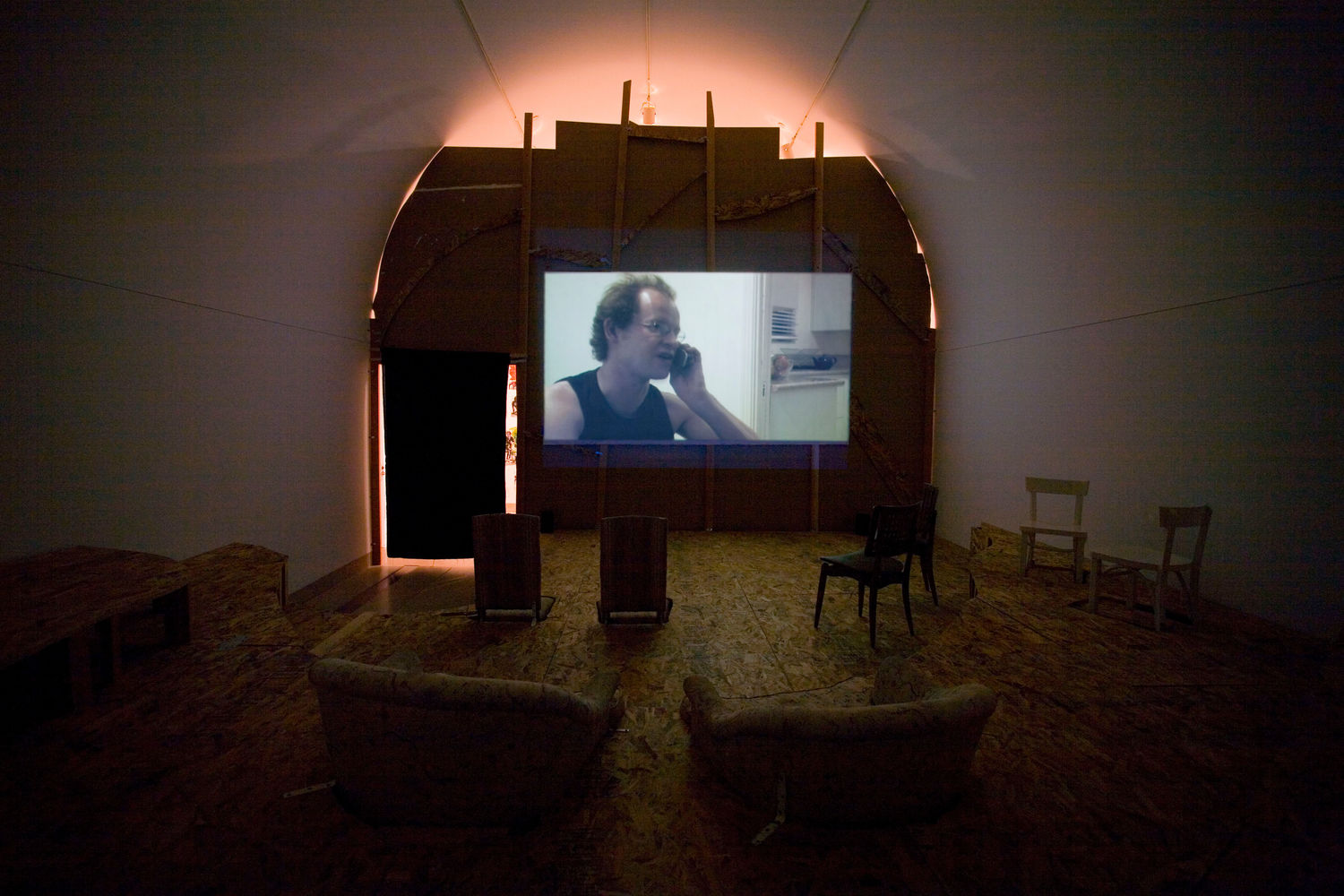
Biography
Erik van Lieshout was born in 1968 in Deurne, the Netherlands, and currently lives in Rotterdam. He studied at the Academy for Art and Design in 's-Hertogenbosch and at Ateliers ’63 in Haarlem. Recent solo exhibitions include a major survey show at the Museum Boijmans Van Beuningen, Rotterdam, which travels to the Kunsthaus Zürich and the Städtische Galerie im Lenbachhaus, Munich. Following his American museum debut at the Hammer, he will have an exhibition at Mass MoCA, North Adams, Massachusetts, in April 2007. Selected group exhibitions include Populism at the CAC Vilnius, the Frankfurter Kunstverein, and the Stedelijk Museum, Amsterdam, and Ethnic Marketing at the Centre d’Art Contemporain, Geneva. In addition, his work was featured in the Fourth Berlin Biennial for Contemporary Art (2006); the Gwangju Biennale (2006); and the Biennale of Sjarjah, Dubai (2004). In 2003 Van Lieshout presented a special installation and video for the Dutch Pavilion at the Venice Biennale. His films have been screened at the Oberhausen Short Film Festival and the Frieze Art Fair in London.
Essay
Erik van Lieshout always seems to wind up in unfamiliar, uncomfortable, and often confrontational situations, and it’s not unintentional. As the artist says: “My challenge is to lose control. . . . Because it’s only when you lose control that you have the feeling of freedom. In fact I am a control freak who is trying to lose control in order to get himself into the craziest possible situations, and thus get over his fear.”
Once people understand that Van Lieshout is not trying to exploit them, they more openly share their opinions with him—however controversial or off-color they may be. Whether visiting a house full of crack heads, teaching female Chinese students words for feminism and empowerment, or having coffee with former Nazi sympathizers in Germany, he treats all his interlocutors with the same respect and consideration. In his videos these interactions are collaged together with more intimate views of the artist, in which we see him enraged, hopeless, crying, laughing, and running scared. This heightens the intensity of Van Lieshout’s hyperactive adventures, and viewers often become uncomfortable watching the display of raw emotion and politically incorrect behavior. This is the point where the artist loses control and lets the situation take over, and his unfettered vision rips open polite society’s shielded, festering wounds.
Van Lieshout usually plays the central role in his videos: he’s the victim and the hero. “Sometimes . . . it’s better to have a look at subjects . . . as they relate to oneself first, before saying anything about other people. That’s why I appear so frequently in my films.” And he is able to get away with more as the director and star, but in his work for the Hammer Museum, he is experimenting by using his longtime collaborator and film editor Core van der Hoeven as his costar, a situation that is challenging and exciting.
In his drawings and collages, Van Lieshout retains the intimate connection with his audience that he establishes in his videos, depicting himself, his friends and family, celebrities, and political figures in a harsh, exposed state. The drawings function as character studies and film stills, freezing vignettes and scenes, illustrating relationships or emphasizing certain characteristics of the people he encounters on his journeys.
After Van Lieshout had spent a few weeks in Los Angeles (with Van der Hoeven by his side), I sat down with him to find out what he had been doing and where he is going.
Ali Subotnick: What do you remember about your first visit to L.A., more than ten years ago?
Erik van Lieshout: The beautiful landscape is still super nice and beautiful. Ten years ago it wasn’t as glossy and shiny, bling bling. Now the Jonathan Borofsky sculpture (Ballerina Clown, 1989) looks really old and very small, but the cars are much bigger now and much shinier.
AS: What are you trying to do now?
EvL: The thing I want to do most is to go straight to Iraq, but “relax” is what my editor and friend Core told me. I can always do that later. My energy level is huge, and I want to fight against dishonesty and capitalism, but as Core says, I should also learn about other things and myself and get to know the situation in the heart of capitalism: Los Angeles. So I'm here and we go to the beach and the Hollywood sign; I eat burgers and we want new sneakers too! So we'll see what happens, but for me the big question is war. That’s a cliché, isn’t it?
AS: War isn’t a cliché. It’s a reality but one that’s barely visible in day-to-day life in the U.S., especially in L.A. What sort of story do you want to tell in your new film? Do your initial ideas change as you’re filming, or is it highly planned?
EvL: No it’s not planned, and yet it’s super planned. I’m most interested in myself and my friend Core. And then we will go somewhere.
AS: Are you looking for something or running away?
EvL: I'm looking for the war, but relax, take it easy. I will walk around with my glass of champagne, so I'm running away, I know!
AS: Tell me about the frog that follows you everywhere.
EvL: My life can be hell. It seems like I'm a nice guy. Damn it, I am a nice guy. But sometimes there is a vulnerable, invisible frog on my back. Sometimes it’s gone, sometimes it’s sleeping, and sometimes it’s something else. . . . The frog is most visible after you’ve been very scared or in a lot of pain or in a painful situation. After that, there is the frog: very clear, burping, stinking, and vulnerable. After the action the frog always comes out . . . the visible thing, that is the frog. And when people start complaining about it, you can tell them not to worry. I just cut off some legs or arms, and it goes away.
AS: I think we've all got a frog, but you seem to have a real love-hate relationship with yours. What are you afraid of?
EvL: I’m most scared when I’m with women because I'm so vulnerable. I often cross the line, and they get angry, and I think, “Why am I scared?” (Is that naïve?) For example, fighting alone in a group of campers, I don’t care. I took boxing for several years, and I’m super fast. I don’t have to be scared at all because I look innocent, and that has saved my life many times. There was this festival called the kermis in Les Ardennes, a black forest in Belgium. It was a big party in a very small village. I talked with a nice girl, and her boyfriend hit me in the face. I had my glasses on, and two minutes after I started talking to the girl, the guy beat me up. When men have a problem with each other, they say it straight to your face. I like being with women very much. They have many ideas about the world, and when it comes to discussing feelings, it’s much more interesting to talk with women. Women also gossip a lot, and that’s a good thing—I like to do that too. But in the end I get along better with men. They are not afraid to fight me. When I start arguing with women, it becomes so complicated (maybe it’s just me), but with men it seems easier. (My mother was super dominant, and maybe that’s why I get along this way with women.) In the U.S. it’s different. The boys look very big, and I need some time to get to know them. Here, every time I start getting my camera out of my bag, the police want to take me to jail. (Seriously!) They’re worse than the Nazis in Germany. My friend Core thinks the Americans seem like they’re all on heavy drugs rather than being Nazis, but that’s my interpretation.
Ali Subotnick is adjunct curator at the Hammer Museum.
Quotations in the introductory text are from an interview with the artist conducted by Rein Wolfs and Miriam Varadinis, “Cut the Performance in the Edit,” in This Can’t Go On (Stay with Me), exhibition catalogue, Museum Boijmans Van Beuningen, Rotterdam; Kunsthaus Zürich; Städtische Galerie im Lenbachhaus, Munich (Zurich: JRP/Ringier, 2006).
Hammer Projects is made possible with support from The Horace W. Goldsmith Foundation, the Annenberg Foundation, Fox Entertainment Group's Arts Development Fee, the Los Angeles County Arts Commission, members of the Hammer Circle, and the David Teiger Curatorial Travel Fund.
Hammer Projects: Erik van Lieshout was created during a residency this winter at the Hammer Museum. The Hammer Museum’s Artist Residency Program was initiated with funding from the Nimoy Foundation and is supported through a significant grant from The James Irvine Foundation.
This exhibition also received support from The Consulate General of The Netherlands in New York.


